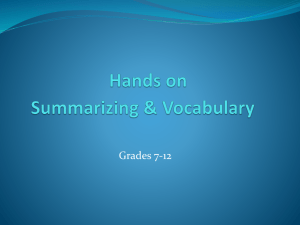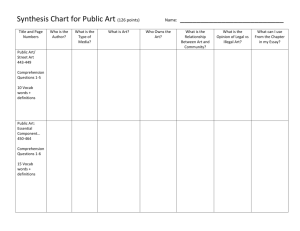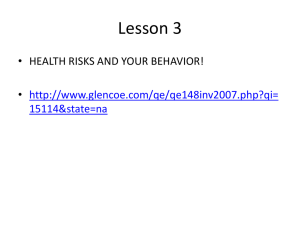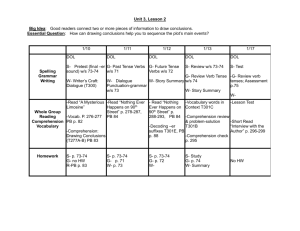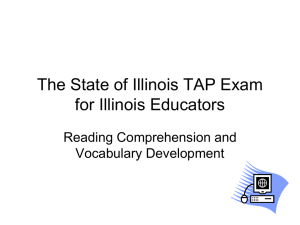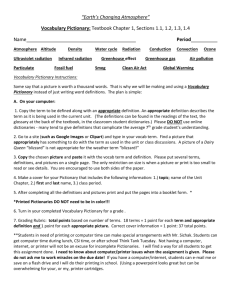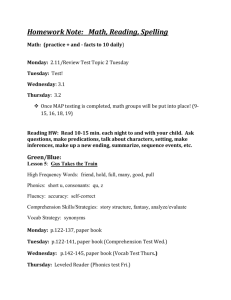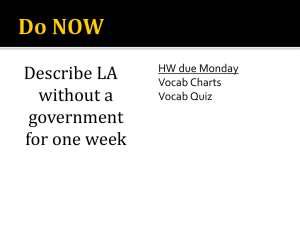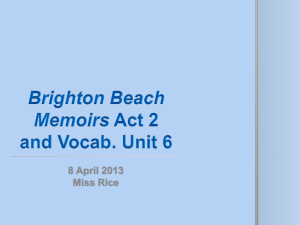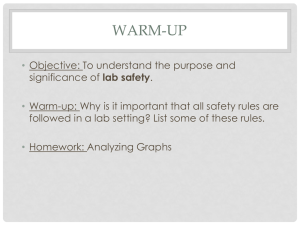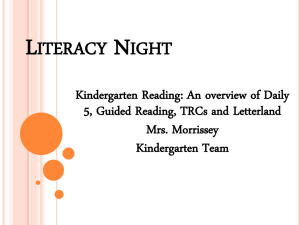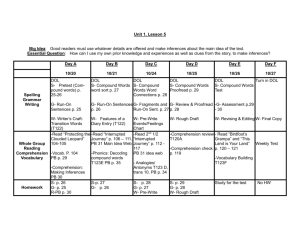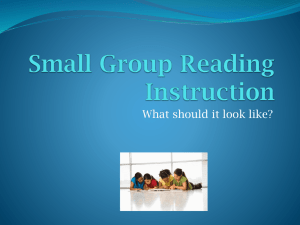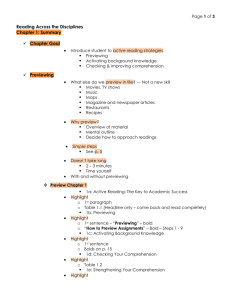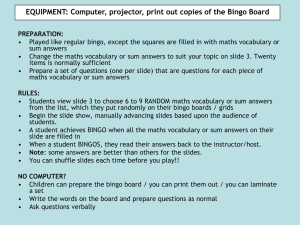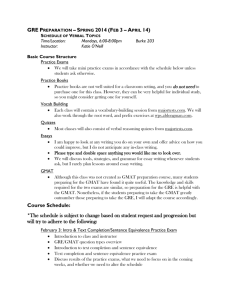Vocabulary K-6 - CurriculumWR
advertisement
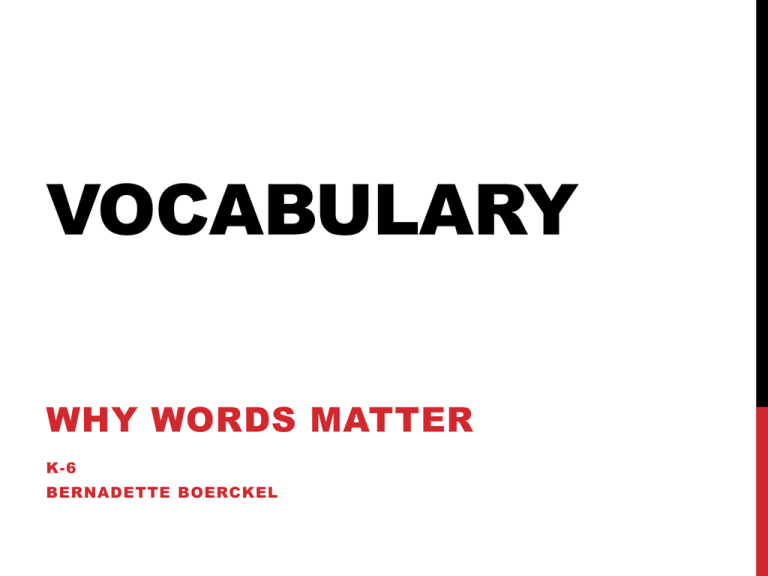
VOCABULARY WHY WORDS MATTER K-6 BERNADETTE BOERCKEL WE KNOW THAT… • A child at or below the poverty line typically hears 600-700 words per hour at 12-18 months old at home • =5000 words by kindergarten • A child from a middle class typically hears 1200-1300 words per hour at 12-18 months old at home • =9000 words by kindergarten • A child from an upper income family hears 2900-3100 words per hour at 12-18 months old at home • =15,000-20,000 words by kindergarten -National Inst. Of Health 1999 WE KNOW THAT • Students must know 95% of the words they hear and read for successful comprehension • Memorizing new words doesn’t help students learn…especially the lower-income set • They have no context / background knowledge • We must BUILD context and connections • Comprehension is greatly enhanced when students can identify examples or applications as well as non-examples. • Elaboration! • Non-verbals WE ALSO KNOW… • Previewing helps comprehension later and provides… • The MULTIPLE EXPOSURES that help to solidify vocabulary acquisition STEPS FOR PLANNING VOCAB INSTRUCTION 1) Provide a description, explanation, or example of the new term 2) Ask students to restate the description, explanation or example in their own words (spoken or written) 3) Ask students to construct a picture, symbol, or graphic representing the new term 4) Engage students periodically in activities that help them add to their knowledge of the terms in their notebooks 5) Periodically ask students to discuss the terms with one another 6) Involve students periodically in games that allow them to play with terms -Building Academic Vocabulary, Alexandria, VA: ASCD LET’S EXPERIENCE THIS It is hard to define words when you don’t have words. PLAY TABOO I STRUGGLE WITH THE VISUAL We know that non-verbals work…but they are so hard! One partner face the screen, the other the back wall. Ready for some Pictionary? From the words shown, choose whichever you want. If your partner gets it, move to another word. Ready….. PICTIONARY laser diagonal comfy biscuit hydrogen macaroni Rubber darkness vegetarian exercise shrew chestnut ditch wobble glitter neighborhood dizzy fireside retail drawback fabric barber mirror migrate drought logo jazz REVIEW OF BEST PRACTICES: PREVIEWING • Choose the MOST ESSENTIAL words to preview • No names • No places • Content words • Process words • Comprehension words THEN… • Discover or build background knowledge ACTIVATING AND PREVIEWING STRATEGIES Do I Know What These Words Mean? (pg 59) Word opine exacerbate chasm stereoscope Not at all Have Seen Think I know (example) Know and Can Use (Description) VOCABULARY ACTIVITIES Word Knowledge (pg 62) Word sobriquet lamster avuncular brachiate Prior Knowledge New Knowledge VOCABULARY ACTIVITIES Word Maps and Charts (pg 64-68) -What the word is -what the word is like -examples of the word brainstorm Word Splash metacognition confidence Word Sorts / Picture Sorts (pg 79) • Students fold a piece of paper forming eight boxes • Tear on folds • Give students a topic (government) • Ask them to write six words (one per paper) and save two • In groups of four, combine words and sort them into categories • Use the blanks to label categories (Open Sort) • If the teacher gives categories (Close Sort) • Can be used with pictures for non-readers Lingo 1. Pass out or fold paper into 9 squares. 2. Call on 9 students to choose a word from the word wall. 3. As a student chooses a word, everyone writes the word somewhere on their grid. 4. When everyone has filled up all 9 spaces, you are ready to play. 5. The teacher (who has written the 9 words down, too) calls off one at a time. 6. Students chant the spelling of each and cover the word. 7. The first student to complete a row wins. WORD WALL Oak Maple Sumac Apple Pear Cherry Bush Shrub Plant analyze categorize classify compare contrast discover divide examine inspect simplify survey take part in test for distinguish list distinction theme relationships function motive inference assumption conclusion dissect 5-3-1 (with Pair Square) (pg 85) • Write down 5 words (on your own) about the reading or topic • Pair to choose the 3 BEST words • Square (4) and as a group, decide on the 1 best word to explain the meaning of the content and explain why the word was chosen to the class. Is this a Vocabulary or a Summarizing Activity? BOTH VIDEO How does the video you just saw and 5-3-1 relate to the solid vocabulary practices? Try it using the content of the video. Charades You know how it works….but did you know it is at the top of Bloom? Create: Dramatize: Role-play! Let’s try it. Charades -------------------------------------------------------Relay / Telephone Charades • Split the class in half • Have each half form a line facing away from one another. Sit down. • The first person in line taps the next and acts out a word. When the person thinks they have it, they clap twice. The actor sits and the new person acts out what they “thought” the word was to the next person. • The last person runs to the front and writes the word down. Quick Talk (Talk As Fast As You Can) (pg 105) (Like Taboo, but with no restrictions) • Use this to reinforce words learned already • Put words up on the board • Class is in partners with one partner facing words • Describe the words as fast as they can • First team to get them all jumps up and cheers for a reward Ready to try? Get partner in the right place. -Rules: can’t say any part of the word! -Can skip and come back to Shout when finished! WORDS IN EDUCATION 1. Differentiate 6. Lecture 2. Accelerate 7. Adaptation 3. Instruct 8. Final exam 4. Overhead Projector 9. Blue book 5. Chalk dust 10. Seminar I Have…Who Has… (pg 104) • Create cards in advance and pass out to students: • Examples: • I have a polygon. Who has a 3-sided figure with a right angle? • I have a triangle. Who has a 4-sided figure where all four sides are equal? • I have a square. Who has…. Graffiti / Carousel Summarization • Prompts, key terms, or concepts are strategically placed around the classroom. • Teams of students rotate from prompt to prompt, adding information to the chart or responses at each station. Each group’s response must differ from those who wrote previously. • (Carousel: Groups stay, paper is passed on cue) • Let’s try it! Concentration (pg 145) • Fold paper into 8 sections. • Write down 4 words and 4 definitions to those words • (i.e. Snow …..frozen rain, Rain…..liquid precipitation) • Rip up, mix up with partner, all face down in rows • Play concentration. Keep your matches. Connect 3 Vocab Word • Write sentences to connect the words in any order around the triangle • Could pictures be used? Vocab Word Vocab Word lamster 1930s sobriquet Give One, Get One (pg 137) • Students create lists of words that relate to a topic for 2 minutes. • Students walk around the room giving and getting new words, one per person. • Time this until students have between 5-10 new words • Students now work in pairs to divide their list into 2 categories, discarding words that do not fit. (May use resources here) • Students now can create posters displaying words from one category using pictures as well to define the meaning • These can be posted as visual vocabulary guidance. Review your notes / slides from the beginning on Vocabulary Research. (2 minutes) List as many words you can that relate to these concepts…stretch (2 minutes) Give one, get one (4 minutes) Back and categorize – create poster with one key concept, vocabulary, and image(s) Post and share PRIMARY WORD WALL ACTIVITIES See pages 189 – 197 INTERMEDIATE WORD WALL ACTIVITIES See pages 199-203 EXPLORING THE BOOK With a partner, read through each activity. Imagine a word wall that you have or use a lesson plan in front of you to work one of these activities in. Be prepared to share what you used and how it will look in the classroom.
